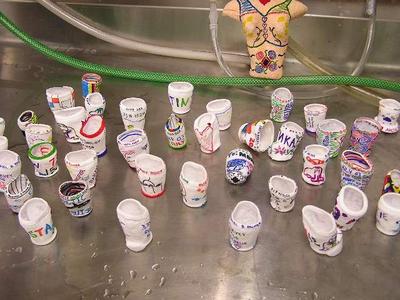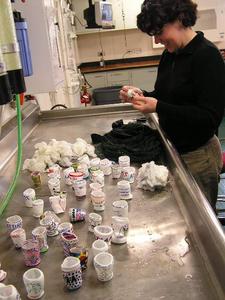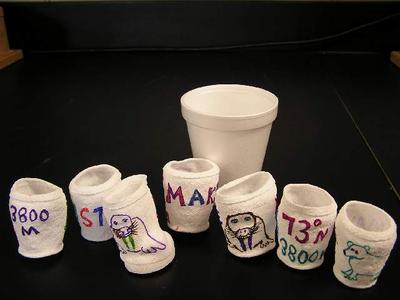15 July, 2003
Simply put, we are in deep water. For the last three days or so we
have been in the waters of the Canada Basin that range from 3000-
4000 meters deep. Each CTD cast is very challenging and time
consuming for everyone involved since it can take three hours or more
to lower and retrieve the rosette. Then it may take another hour or
so to draw all the samples from the water bottles.
So it was no small consideration to add yet another experiment to the
already demanding routine of around the clock data gathering. But
we're here to do science and everyone cheerfully accepts the
additional responsibility. In fact, this test is so interesting,
that almost everyone on board the Palmer plays a part in its
execution at Station 37.
In preparation for the experiment, many of the officers and crew to
most of the scientists and technicians have contributed a fair amount
of effort getting ready to guarantee the successful completion of the
Great Styrofoam Cup Crush Test. Parcticipants have spent hours
rendering realistic drawings, decorative designs, and noteworthy
names on a large number of quite ordinary Styrofoam cups. Many cups
feature stylized portraits of marine mammals with the walrus being
the most popular. I include the names of my several nieces and
nephews on each cup. Perhaps the most impressive cup shows a
beautiful "painting" of the R/V Nathaniel B. Palmer in amazing
detail. Indeed, several budding artistic styles are readily
recognizable.
All of the cups, and one partial female mannequin torso, are placed
into a mesh bag and attached to the bottom of the rosette which will
be lowered to a depth of 3830 meters. The 380 atmospheres will
produce about 5600 pounds of pressure on every square inch of each
cup. Needless to say, everyone feels the "pressure" of this most
critical and significant experiment. (Check out the images for the
results.)

Cups, and one torso, after their dive to 3830 meters.

Marine mammal biologist, Heather Smith, removing the test cups from the net.

Test cups and original for comparison.
Contact the TEA in the field at
.
If you cannot connect through your browser, copy the
TEA's e-mail address in the "To:" line of
your favorite e-mail package.
|
